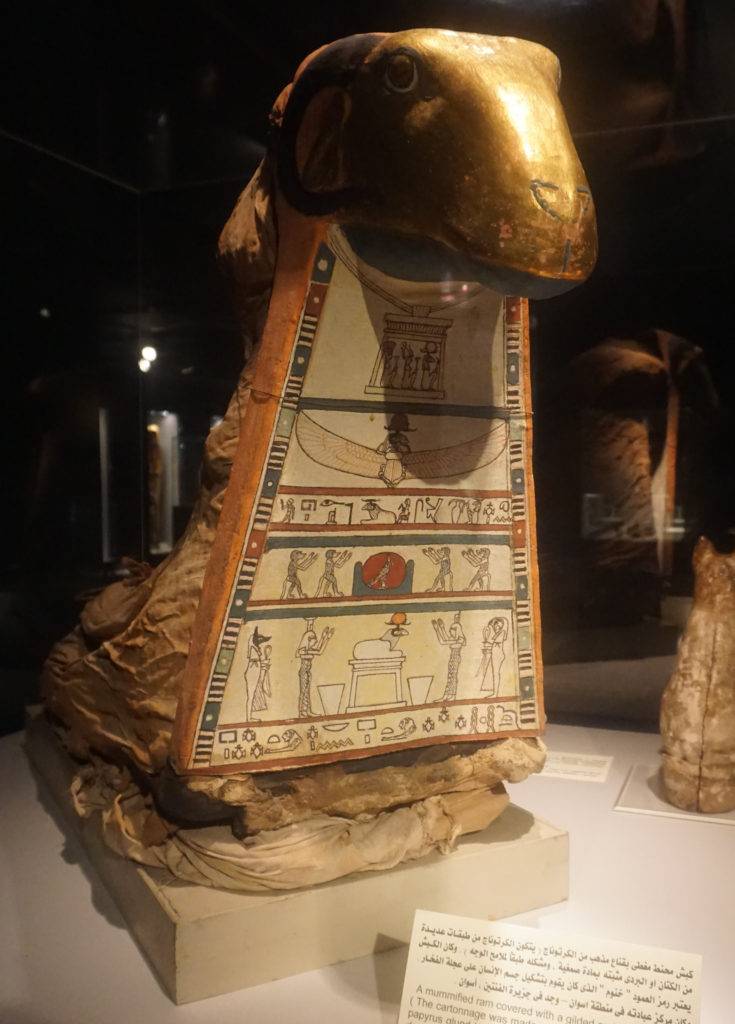Mummification Museum
exhibits explaining the art of mummification
The Mummification Museum is an important museum in Luxor that showcases the art of preserving the bodies of ancient Egyptians through mummification. The museum, located north of Luxor Temple on the Nile Corniche, was opened in 1997. It provides insight into the process used by ancient Egyptians to preserve human bodies and those of animals such as cats, dogs, and crocodiles. Anubis, the god of embalming and mummification, was often depicted as a jackal.

Mummification in Ancient Egypt
Mummification was an important part of ancient Egyptian culture. It involved carefully removing organs from a body, drying it out with special salts, and wrapping it in bandages. The goal was to preserve the body, so the person’s soul could use it in the afterlife. Over time, the process got better and better, and it reached its peak during the New Kingdom Period.

The ancient Egyptians believed in preserving the body after death for immortality.
Luxor Tours & Activities
Looking to save some costs on your travel? Why not join a shared group tour to explore Luxor, Egypt? Here are some activities you might be interested in:
Location of the Mummification Museum
Canopic Jars
The ancient Egyptians used Canopic jars to store and preserve their owners’ organs for the afterlife during the mummification process. These jars were made of limestone or ceramic and were used from the Old Kingdom to the Late Period, or Ptolemaic Period. The viscera were not stored in a single Canopic jar but in separate jars for different organs. The word “Canopic” comes from early Egyptologists’ mistaken link to the Greek mythology of Canopus.
Canopic jars from the Old Kingdom had a simple cover and were rarely engraved. Inscriptions became more common in the Middle Kingdom, and human heads were often depicted on the lids. By the Nineteenth dynasty, each of the four lids showed one of Horus’ four sons as protectors of the organs.


The ancient Egyptians used special jars to keep the organs they removed from a body during mummification. These organs were the lungs, liver, intestines, and stomach. The jars had lids with the heads of four Sons of Horus carved on them. They were Hapy, Imsety, Duamutef, and Qebehsenuef. Hapy was represented by a baboon head, Imsety by a human head, Duamutef by a jackal head, and Qebehsenuef by a falcon head. This way, it was easier to know which jar held which organ. This was common during the New Kingdom era.
Displays at the Mummification Museum
At the entrance to the museum, there is a display of well-preserved mummy cases, mostly from the dryer climate of Upper Egypt. This display also includes a statue of Anubis, the jackal-headed god who leads the dead into the underworld.
Inside the museum, you can find several artifacts associated with the mummification process, which are displayed in glass cases. Each artifact is accompanied by a detailed description of its use, including model funerary boats, amulets, and a fine set of Canopic jars.
Additionally, the museum houses several animal mummies, such as a crocodile, a cat, and a ram of Khnum with its gilded case from Elephantine.

Deities and Symbols of Ancient Egyptian
Anubis was a deity worshiped by the ancient Egyptians. He was believed to be the inventor of mummification and was considered the guardian of the dead and their Necropolis. The Jackal was his sacred animal. In the tombs of Deir el-Medina and other places on the west bank of Luxor, he is often depicted as a man with a jackal head accompanying a mummy reclining on a burial bed.


A mummified ram, covered with a gilded cartonnage mask, was also considered significant by the ancient Egyptians. The cartonnage was made with different layers of linen or papyrus glued together and shaped like the features of the deceased. The ram was believed to be the symbol of the god Khnum who was responsible for shaping the human body on his potter’s wheel. The main place of Khnum was in Aswan, found on Elephantine Island.

The Setep implement was used during the Opening of the Mouth ceremony. This ceremony was performed to give back energy and vitality to the deceased before placing the mummy in the tomb.


Significance of the Mummification Museum
The ancient Egyptians had a strong reverence for crocodiles and worshiped them. The cult of the crocodile god was based in Kom Ombo where crocodiles were kept in a pool within the temple precinct. The temple of Kom Ombo has a chapel where the crocodile pool is located. The Mummification Museum is a great place to learn about the rituals surrounding ancient Egyptian death. These rituals were an important part of the ancient Egyptian religious system and continue to influence modern funerary practices. The Mummification Museum’s library is an excellent source of information on this intriguing topic.
F.A.Q
9:00 AM-2:00 PM Every Day
FOREIGNER:
Adult: EGP 200\ Student: EGP 100
EGYPTIANS\ ARABS:
Adult: EGP 20\ Student: EGP 5
The Mummification Museum is a great place to learn about the rituals surrounding ancient Egyptian death. These rituals were an important part of the ancient Egyptian religious system and continue to influence modern funerary practices.
On the East Bank of the Nile River(Kornish Al Nile), Situated north of the Luxor Temple overlooking the Nile.
